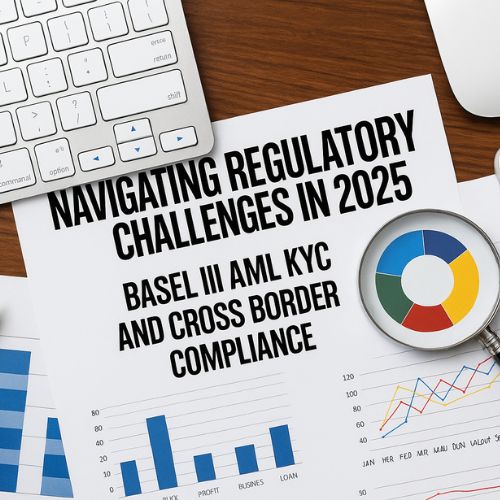This blog examines the shifting regulatory landscape for financial institutions, highlighting Basel III delays, advanced AML/KYC requirements, and growing cross-border compliance complexities. It explores how banks can leverage RegTech, data integrity, and agile compliance frameworks to adapt, enhance resilience, and maintain competitiveness. Readers gain insights into future-ready compliance strategies that turn regulatory challenges into opportunities for operational efficiency and strategic growth.
The regulatory landscape for financial institutions has become increasingly intricate and pivotal to operational success. Banks and financial services firms are confronted with a pivotal juncture, marked by postponed Basel III implementations, advancing anti-money laundering (AML) mandates, and disparate cross-border compliance frameworks that are fundamentally altering business practices.
For compliance officers, risk managers, and senior executives, the focus has shifted beyond mere adherence to regulatory checklists. It now encompasses embedding resilience into core operations while preserving a competitive edge in an environment characterized by persistent regulatory flux.
Key Challenges of Basel III Implementation
The implementation of Basel III has shifted far from initial expectations. What was meant to be the final phase of post-financial crisis reforms has turned into a long, drawn-out negotiation, creating more confusion than clarity.
Data highlights this complexity. In the U.S., regulators are rethinking proposals that would have raised capital requirements for big banks by 16–21%. The Federal Reserve has softened its stance after strong industry feedback, but this shift makes it harder for banks to plan while rules continue to change.
A key challenge is the growing global fragmentation. While U.S. regulators refine their approach, authorities in Europe and the U.K. have delayed their timelines, citing uncertainty around U.S. progress. This has raised concerns among experts that standards may be weakened across regions in the name of competitiveness.
Institutions navigating this terrain must balance immediate preparations with adaptability.
According to a survey by Fitch Solutions, 40% of banking professionals identify data quality as their primary Basel III obstacle, while 32% are proactively adjusting business models in response to anticipated reforms that may ultimately differ from original designs.
The operational impact is significant. Banks need to upgrade risk management systems to support the Standardized Measurement Approach, while also keeping room for future amendments. This requires major investment in time, resources, and strategic planning.
For a deeper dive into operational risk modelling within Basel III frameworks, explore our white paper on operational risk modelling in banking.”
AML and KYC Compliance with Advanced Technology
While Basel III remains a moving target, AML and know-your-customer (KYC) compliance is advancing rapidly, giving banks and financial institutions new opportunities to leverage technology effectively.
The Financial Action Task Force has strengthened its rules on beneficial ownership under Recommendation 24 that extend beyond routine obligations and pushes for enhanced transparency. This shift encourages institutions to treat compliance not just as a cost, but as a potential strategic advantage.
In transaction monitoring, for instance, AI-driven systems have demonstrated reductions in false positives by up to 70% and improvements in detection efficacy by 40%. These advancements bolster compliance and enhance operational efficiency, yielding tangible financial benefits.
AI-driven transaction monitoring is already showing results—cutting false positives by up to 70% and improving detection rates by 40%. Similarly, digital KYC is reshaping customer onboarding. By 2025, more than 70% of onboarding is expected to be automated, using tools like biometric checks and advanced analytics. This speeds up customer integration, improves user experience, and reduces manual effort. Leading banks, for example, have cut false alerts by 75% using our proprietary AML compliance solution.
The RegTech sector is growing fast, projected to surpass $22 billion by mid-2025 with a 23.5% annual growth rate, proving that focused compliance investments can deliver strong returns.
Still, regional differences remain a challenge. Europe emphasizes risk-based frameworks, the U.S. focuses heavily on sanctions and international data exchange, and Asia-Pacific is advancing digital identity protocols alongside stricter ownership rules.
The best approach is to build adaptable compliance frameworks that can handle these differences without needing constant redesign.
Cross Border Compliance and Global Integration
Cross-border operations have always been complex, and this year, regulatory differences across regions have made compliance even more challenging for banks and financial institutions.
Without uniform global rules, multinational banks face a patchwork of regulations covering licensing, product distribution, and data privacy. For example, an investment product allowed in London might not meet New York rules, and GDPR-compliant data practices in Europe could conflict with emerging privacy laws in Asia.
Technology is key to managing this complexity. Leading institutions are using API-based systems to embed compliance directly into onboarding, advisory, and trading processes. Real-time monitoring with Key Risk Indicators (KRIs) helps banks track market risks while staying compliant.
Thus, the ISO 20022 standard is becoming important for cross-border payments. It provides richer data, improves transparency, strengthens compliance, and makes systems work better together. For banks handling large volumes of international transactions, adopting this standard not only meets regulations but also improves efficiency and customer experience.
European Union AML Directive and Its Impact
The European Union’s AML package, effective from July 2025, constitutes a landmark evolution in regulatory oversight. The Sixth Anti-Money Laundering Directive (AMLD6) transcends incremental updates, redefining AML governance across the EU.
AMLD6 now applies not only to banks but also to crypto-asset providers, crowdfunding platforms, and even organizations like football clubs. Customer Due Diligence (CDD) thresholds have been lowered from €15,000 to €10,000, and crypto transactions over €1,000 are now closely monitored.
A key feature is the creation of the European AML Authority (AMLA) in Frankfurt. AMLA provides unified EU-level supervision for cross-border operations, replacing the previous 27 separate national regimes. It sets technical standards and harmonizes regulatory oversight, simplifying compliance for institutions operating in multiple countries.
The directive’s implementation will continue until 2029, giving banks a phased period to adjust. Compliance teams need to manage parallel initiatives while keeping day-to-day operations running smoothly. New risks, such as those from crypto transactions, require updated approaches, as detailed in our white paper on mitigating financial crime risks in the age of cryptocurrency and related success story on crypto KYT alert clearance.
Building Future Ready Compliance Strategies
In today’s constantly changing regulatory environment, banks and financial institutions need compliance frameworks that can evolve rather than remain fixed.
Top-performing institutions are using this opportunity to modernize their compliance systems. By investing in RegTech, they can automate routine processes, monitor activity in real time, and maintain detailed audit records that meet multiple regulatory requirements simultaneously.
Data quality is critical. Whether for Basel III calculations or verifying beneficial ownership, banks need strong, reliable data systems that work across different regulations without requiring constant manual intervention.
Collaboration across departments is essential. Compliance can no longer operate in isolation—risk, technology, operations, and business teams must work together to develop solutions that meet regulatory standards while supporting strategic business goals.
Leading institutions view compliance not just as a cost, but as a strategic advantage. Efficient onboarding, better risk management, and streamlined processes help banks stay compliant while improving client experience and maintaining a competitive edge.
Conclusion
Current regulations are complex and constantly changing, but they also create opportunities for banks and financial institutions that adapt strategically.
By investing in resilient, technology-driven compliance systems, institutions can turn potential risks into strengths. This approach not only ensures ongoing regulatory compliance but also supports operational excellence, better client experiences, and a strong position in the market.
Anaptyss helps banks and financial institutions navigate regulatory complexities with tailored managed services. From RegTech integrations and risk management enhancements to compliance framework optimization, our solutions are designed to build resilience, efficiency, and competitive advantage. Partner with our experts to future-proof your compliance strategy. For more information, reach out to us at info@anaptyss.com.



